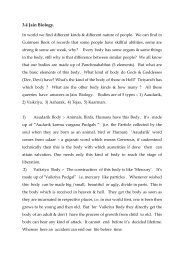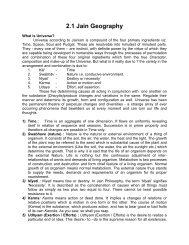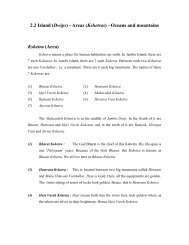âæ¢ ç¸ï¼¯ï¼ è£æ½® J - Jainism, Jain Religion - colleges
âæ¢ ç¸ï¼¯ï¼ è£æ½® J - Jainism, Jain Religion - colleges
âæ¢ ç¸ï¼¯ï¼ è£æ½® J - Jainism, Jain Religion - colleges
Create successful ePaper yourself
Turn your PDF publications into a flip-book with our unique Google optimized e-Paper software.
• A bull is as powerful as 12 warriors are.<br />
• A horse is as powerful as 10 bulls.<br />
• A buffalo is as powerful as 12 horses.<br />
• An elephant is as powerful as 15 buffaloes.<br />
• A lion is as powerful as 500 elephants.<br />
• An octoped is as powerful as 2,000 lions.<br />
• A Baldev is as powerful as 1 million octopeds.<br />
• A Vasudev is as powerful as 2 Baldevs.<br />
• A Chakravarti is as powerful as 2 Vasudevs.<br />
„±üü ¿¢¢Ý¢² ½±¼é J<br />
• A king of serpent gods is as powerful as 1,00,000 Chakravartis.<br />
• An Indra is as powerful as 10 million kings of serpent gods are.<br />
• The power of innumerable Indras is insignificant as compared to that of the small finger of a Tirthankar.<br />
APPENDIX 14<br />
THE CONSTRUCTION OF THE DIVINE PAVILION OF TIRTHANKARS<br />
[Like many other branches of science the branch of constructing assembly halls has also amply developed. To construct a<br />
large auditorium where thousands of people may arrive, be accommodated, may listen to the lectures and peacefully leave,<br />
requires as trained mind with engineering skill. For such an arrangement renowned experts display their skill. Still there are<br />
incidents of chaos and stampede in such large congregations. Even the police forces get nervous in trying to control such<br />
crowds of thousands of people.<br />
Thousands of years ago the divine pavilions were created for the assembly of a Tirthankar where not only millions of human<br />
beings but also innumerable gods and animals used to assemble.<br />
In a large pavilion or assembly hall covering an area of one Yojan (4 sq. Kosa or 12 sq. Km) used to accommodate innumerable<br />
gods, humans and animals. They would arrive and sit in the allotted sections, listen to the discourses of the Tirthankar<br />
and go back peacefully. There were adequate traffic and parking arrangements for vehicles. The detailed and scientific<br />
description of such arrangements available in the ancient scriptures is truly astonishing. It also reveals the highly developed<br />
science and intellect during that period. We give brief description of the structure of these divine pavilions of the Tirthankars.]<br />
jainuniversity.org<br />
The beholding of a Tirthankar in his divine pavilion, pondering over his discourses, and following his teachings purifies and<br />
strengthens the attitude, faith and realization of spiritual pursuits. Sitting in proximity of the Tirthankar, seeing him, listening to<br />
his discourse and coming under the influence of his aura and various unique attributes is spiritually inspiring not only for the<br />
gods and humans but also for the animals. Men and animals of contrasting attitudes loose their cruelty and mutual animosity,<br />
disease, sorrow, afflictions, fear etc. The Tirthankar’s discourse also provides benefits are shape of enhancement of knowledge<br />
and science and progress on the path of liberation through stoppage of inflow and acceleration of shedding of Karmas.<br />
The Great Benefits<br />
Knowing about the arrival of Bhagavan Mahavir in the Samavasaran the sages said, “O beloved gods! This is the source of<br />
great benefits for us. When even the hearing of the names of Arihant Bhagavants is a boon, there is no doubt that approaching,<br />
greeting, bowing, admiring and worshipping him in person is highly beneficial”. It is a great occasion to listen to even one<br />
word of the august preaching of the great man. Bowing to him and offering him reverence is sure to result in attainment of the<br />
pure blissful state of liberation besides being source of benefits, happiness and peace during this life and the later incarnations.<br />
What is a Samavasaran? How it is created? When and for how long the Tirthankar gives his discourse in the Samavasaran?<br />
All these questions have been dealt in various canons (Agams) and their different commentaries (Niryukti, Vritti and Bhashya)<br />
in eloquent style.<br />
The Samavasaran is the religious assembly of Tirthankars. The literal meaning of the term is proper congregation at a<br />
specific place or a place where beings with different attitudes assemble in an orderly manner. As such, the assembling of a<br />
variety of worthy beings-specially humans, animals and gods-for the purpose of a variety of worthy beings-specially humans,<br />
animals and gods-for the purpose of beholding the Tirthankar and listening to his preachings is called Samavasaran. It is<br />
something much larger in dimension, much wider in scope, much numerous in species, and much lofty in purpose as compared<br />
to the modern parliament where representatives from various areas of the country meet.<br />
Amar Muni - Tirthankar Charitra - Surana # 60<br />
www.jainuniversity.org
















